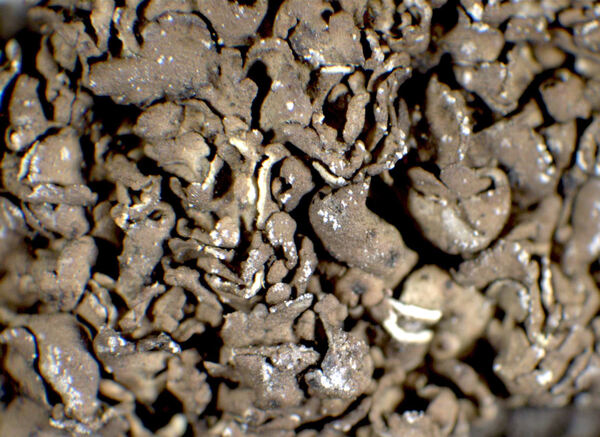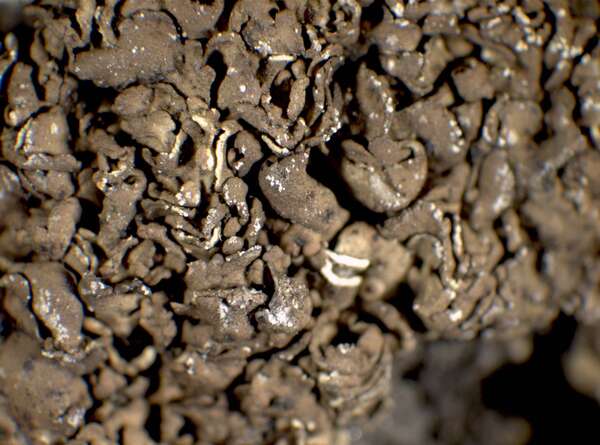Heteroplacidium imbricatum (Nyl.) Breuss
Ann. naturhist. Mus. Wien, 98B: 40, 1996. Basionym: Endocarpon imbricatum Nyl. - Bot. Not.: 161, 1853.
Synonyms: Catapyrenium imbricatum (Nyl.) Clauzade & Cl. Roux; Dermatocarpon imbricatum (Nyl.) Zahlbr.; Endopyrenium imbricatum (Nyl.) Boistel
Distribution: N - VG, Frl (TSB 3062), Ven, Lig. C - Tosc, Umb (Genovesi & al. 2001, Ravera & al. 2006), Sar. S - Camp (Nimis & Tretiach 2004), Si (Nimis & al. 1996b, Grillo & Caniglia 2004, Caniglia & Grillo 2005, Cataldo & Minissale 2015).
Description: Thallus squamulose, pale greyish brown to brown, dull, rarely faintly pruinose at margin. Squamules 1-3 mm broad, 0.15-0.4 mm thick, rounded to crenulate, concave to convex, but usually flattened, smooth, densely imbricate, forming 2-4 cm wide cushions. Lower surface whitish to yellowish white or very pale brown, attached by 4-5 μm thick, pale rhizohyphae which are usually present only at the base of squamules. Upper cortex paraplectenchymatous, 20-40 μm thick, of 4-13 μm wide, angular cells; medulla of globose cells; lower cortex not clearly delimited from the medulla. Perithecia rather rare, laminal, subglobose to pyriform, immersed, to 0.35(-0.4) mm across, without involucrellum. Exciple initially pale, then brown, finally dark brown to black; hamathecium of periphyses, interascal filaments absent; hymenial gel hemiamyloid. Asci 8-spored, clavate, I-, fissitunicate, the wall thickened above, Verrucaria-type. Ascospores 1-celled, hyaline, narrowly ellipsoid, thin-walled, (11-)12-16(-17) x 5-7 μm, biseriately arranged in the asci. Pycnidia laminal, dark, immersed, of the Dermatocarpon-type. Conidia subcylindrical, 4-5 x c. 1 μm. Photobiont chlorococcoid (Myrmecia). Spot tests: cortex and medulla K-, C-, KC-, P-, UV-. Chemistry: without lichen substances.Note: in fissures of hard calcareous rocks and amongst mosses, especially limestone, in rather sheltered situations, at low elevations.
Growth form: Squamulose
Substrata: rocks, soil, terricolous mosses, and plant debris
Photobiont: green algae other than Trentepohlia
Reproductive strategy: mainly sexual
Commonnes-rarity: (info)
Alpine belt: absent
Subalpine belt: absent
Oromediterranean belt: absent
Montane belt: absent
Submediterranean belt: extremely rare
Padanian area: absent
Humid submediterranean belt: rare
Humid mediterranean belt: rather rare
Dry mediterranean belt: very rare

Predictive model
Herbarium samples
Growth form: Squamulose
Substrata: rocks, soil, terricolous mosses, and plant debris
Photobiont: green algae other than Trentepohlia
Reproductive strategy: mainly sexual
Commonnes-rarity: (info)
Alpine belt: absent
Subalpine belt: absent
Oromediterranean belt: absent
Montane belt: absent
Submediterranean belt: extremely rare
Padanian area: absent
Humid submediterranean belt: rare
Humid mediterranean belt: rather rare
Dry mediterranean belt: very rare

Predictive model
| Herbarium samples |
 INDEX FUNGORUM
INDEX FUNGORUM
 GBIF
GBIF
 DOLICHENS
DOLICHENS




